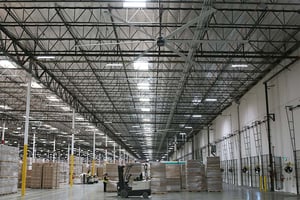Warehouses and logistics facilities generally encompass massive square footage. They are filled...
How To Cool Off a Warehouse – Top 10 Ways
In order to have a highly productive warehouse, it is critical for employees to keep cool in the hot summer months. Equally important, knowing how to cool off a warehouse will better preserve inventory, make the warehouse more energy-efficient, and above all, keep employees more comfortable. Further, when employees operate at an ideal temperature (71°F), fewer mistakes are made and less time is wasted, which is better for your bottom line. Unquestionably, that is something everyone is comfortable with!
Why is it important to cool off a warehouse and have good airflow?
1 – Prevent poor air quality and lack of ventilation
Extreme temperatures can cause a warehouse to have stagnant air. Furthermore, your warehouse can easily become filled with exhaust fumes (and other harmful airborne contaminants) due to a lack of ventilation, which is very dangerous for employees.
2 – Employee Safety
Extreme heat can create hazards with Sweaty Slab Syndrome. The condensation on the concrete floor can cause real safety hazards for people, animals, and equipment. Additionally, people can overheat very quickly in a HOT warehouse causing heat exhaustion or even heat stroke.
3 – Energy Efficiency
When your environment is constantly hot, the HVAC units have to work hard to keep up. This is more expensive for you! This article will give you some great tips on how to cut those costs and keep the environment cooler.
4 – Personal Comfort
Lack of air and cooling will cause poor work and productivity, careless and unsafe work habits, fatigue, and heat exhaustion or heatstroke. Certainly, when you’re hot, sticky, and sweaty, every bit of air movement over your skin feels really good! The air evaporates the sweat on your skin, which makes you feel cooler. Below you will find amazing information on keeping your employees comfortable.
Now that we understand WHY it is important to cool your warehouse, let’s find out HOW to make it happen.
Top 10 Ways to Cool a Large Warehouse
- Fans
- Ventilation
- Insulation
- Cool Roof
- Seal Dock Door and Gaps
- Maintain HVAC System
- Smart Thermostats
- Dehumidifiers
- Turn Off Unnecessary Heat Sources
- Look Outside the Warehouse
1 – Fans
One of the best ways to have a cool warehouse is by adding High Volume Low Speed (HVLS) warehouse fans. They are a necessary part of your cooling and ventilation systems. The addition of large diameter ceiling fans can do wonders in cutting out the excessive heat in your entire warehouse by increasing airflow.

- Reduce temps by up to 8° in your warehouse by moving air from ceiling to floor and from wall to wall.
- Affect up to 20,000 square feet of space with just one fan.
- Create a much more comfortable work environment for employees.
- Reduce energy costs by as much as 30%.
- Range in size from 6-24 feet in diameter.
- Low Operating Costs - as low as $0.37 per day.
2 – Ventilation
Cooling a large warehouse space through ventilation is free and easy! There are some very simple things you can do to increase ventilation and help the overall air quality.
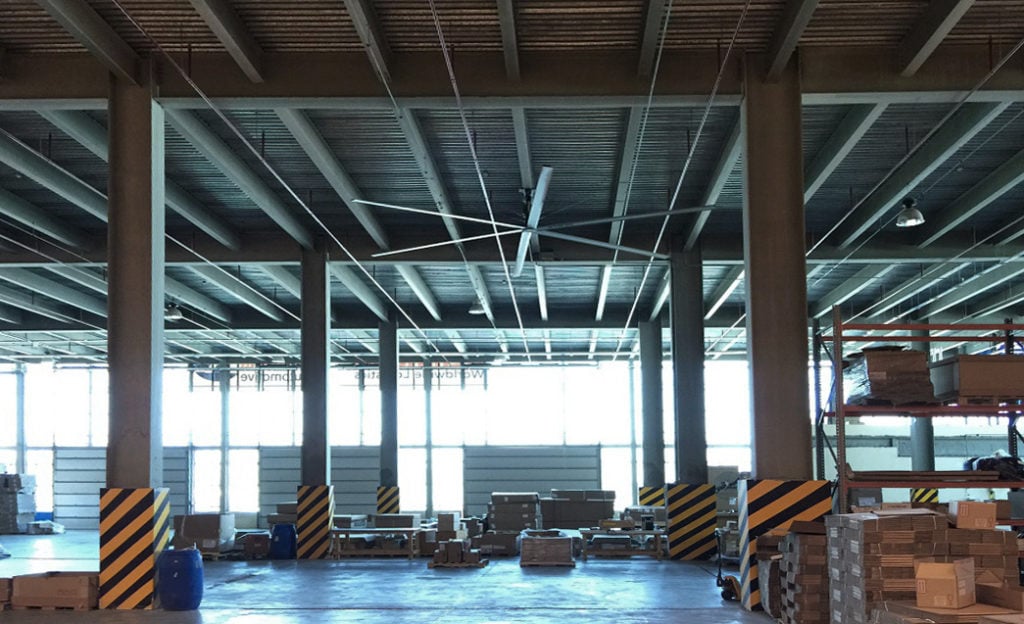
- Open your doors and windows and get a cross-breeze moving throughout your facility when the weather permits. Additionally, this will allow cooler air into the warehouse.
- Add a fan to an open door or window to push stagnant air out and increase fresh air movement inward.
- Further, you can install a metal screen door to keep fresh air moving while keeping bugs and birds out of the warehouse.
- HVLS fans can eliminate ventilation problems because they continuously mix and churn all of the air inside your warehouse.
3 – Insulation
Having a well-insulated building will not only keep your warehouse cool but will also cut your energy costs. Plus it will help to regulate the temperatures inside the warehouse so the warehouse workers are comfortable.
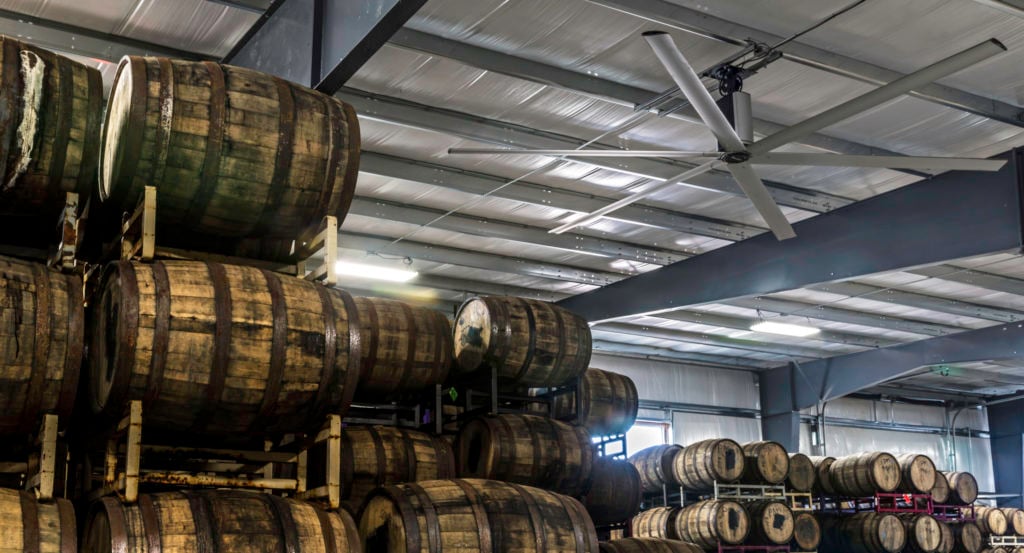
- Make sure your walls and ceiling have proper insulation, especially your outside walls.
- Adding insulation will also cut down on noise and echo within the warehouse.
- Insulation will keep cool air inside the building in the summer heat.
- In the winter months, insulation will keep the heat inside the building.
- Protents temperature-sensitive products.
- Reduces the warehouse’s carbon footprint.
4 – Cool Roof
Roofs can get dangerously hot!! In fact, roof temps can reach up to 150°F in hot summer months. Adding a cool roof is a great way of cooling warehouse space, and cool roofs are available for most roofs.

- Cool reflective roofs have a heat-repelling coating that can reflect the heat off the surface of the roof. Traditional roofs absorb the heat.
- Adding a cool roof reduces the roof temp by up to 50°F.
- They help maintain a comfortable space for employees.
- Adding a cool roof will also extend the life of your roof.
- Save money on energy costs by adding a cool roof.
- Additionally, many states offer rebates for installing cool roofs.
- When completing your roof, finish it in a light color.
5 – Seal Doors and Gaps
Making sure all door and trailer gaps are sealed tight will keep that hot air from moving into your warehouse in the stifling summer months.

Image by claudio losa from Pixabay
- Add loading dock shelters to seal any trailer gaps. They will create a seal between the warehouse walls and truck when it is in the loading & unloading zones
- Loading dock shelters also keep the hot air out and the cooler air in.
- Further, loading dock shelters will keep bugs and birds out.
- Avoid keeping exit doors open for long periods on hot, muggy days.
- Install strip/curtain doors. These are simple doors made of vinyl or plastic that are lined across a loading dock door.
6 – Maintain HVAC System
Warehouse cooling systems are cooling massive amounts of square footage, so keeping up on regular maintenance will help you save money and beat the heat. Therefore, it is important to schedule routine maintenance on your HVAC system.
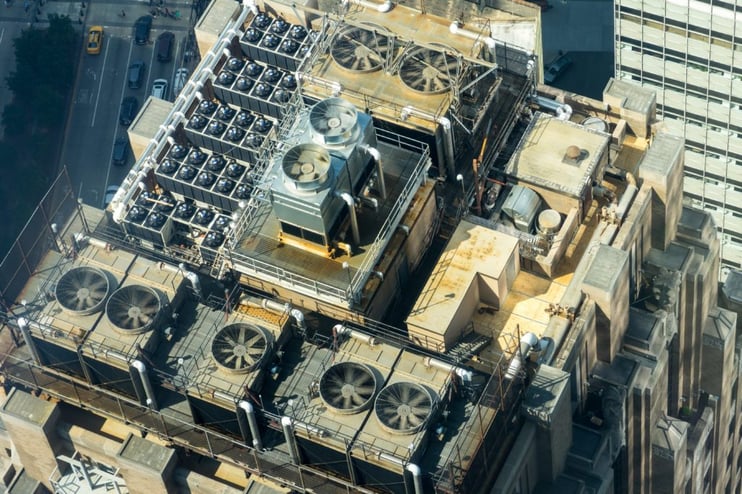
Photo by Sergei A from Pexels
- Change or inspect the air filters.
- Clean or blow out ignition switches along with the blower assembly and housing.
- Make sure the thermostat is running properly.
- Inspect the duct system, belts, heat exchangers, safety controls, and wiring.
- Clean your condensate line and the drip pan.
- If the HVAC is not cooling enough, supplement your system with the addition of HVLS fans. This will help to distribute cool air from the HVAC unit throughout the room. In addition, HVLS fans maintain constant humidity — allowing building managers to raise the AC set-point by as much as 12 – 15 degrees.
- Including HVLS fans in your design enables you to lower the amount of AC tonnage needed by 40%.
7 – Smart Thermostats
Another one of the best ways to cool a large warehouse is by adding smart thermostats. Smart thermostats are like a “little assistant” for the warehouse owner or facility manager. They are energy-efficient and will save the building tons of money in cooling costs!

Image by Gerd Altmann from Pixabay
- Smart sensors are programmable and can sense where your employees are within the warehouse.
- Paired with smart sensors, smart thermostats will switch off the system automatically when no one is there.
- Automatically adjust temperatures based on time of day, weather, and the number of people present.
- Alerts you if the temperature in the warehouse gets too high or too low
8 – Dehumidifiers
If your warehouse is located in a humid environment, dehumidifiers are a must! Humidity will make your facility feel much hotter than it is. Not to mention, muggy weather will cause employees to feel uncomfortable and fatigued.

- Dehumidifiers remove moisture and create a cooler feel.
- Combine your dehumidifier with your HVAC unit for maximum comfort.
9 – Turn off Unnecessary Heat Sources
When hot equipment and machinery run throughout the day, it can drive up the temperature in your warehouse. So, only run equipment and machinery when you need to use them.
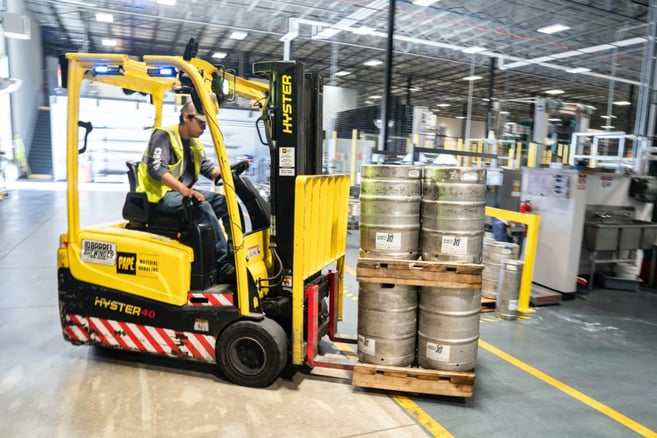
- Turn off equipment and machinery when not in use.
- Keep hot equipment pieces away from each other and away from inventory to avoid overheating and inventory damage.
10 – Look Outside the Warehouse
Pay attention to the perimeter of the building when thinking about how to cool off a warehouse. Many times warehouses are in barren locations with no shade. The lack of shade can cause the exterior of your building to overheat, which will ultimately move the hot air inside, making your employees uncomfortable. To avoid this, plant trees around your facility. This will allow shade, thus lowering the temperature around the building.
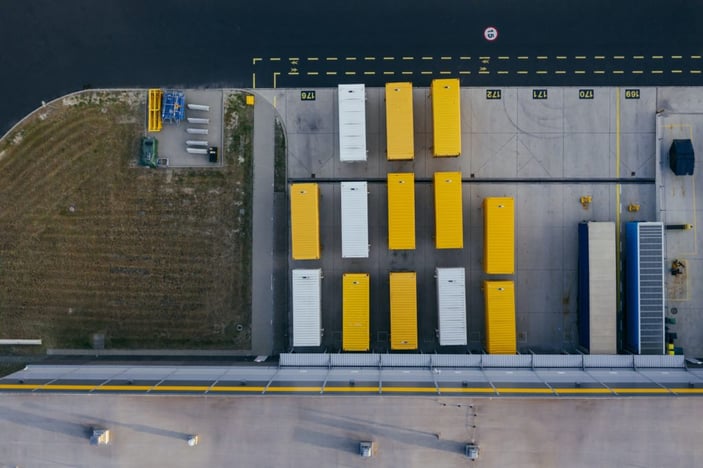
Let MacroAir Help You Cool Your Warehouse Today
MacroAir offers a selection of 6 to 24 ft HVLS ceiling fans for your warehouse that can help you save on climate control costs. Our fans are the most efficient and technologically advanced on the market, and we stand behind their ability to create healthy and well-ventilated environments. Visit our warehouse page for the best information on your warehouse cooling needs.
About MacroAir
MacroAir invented the High Volume, Low Speed (HVLS) industrial ceiling fan. They have continued to be leaders in the market by developing the most innovative large fans in the world. They continually strive to push boundaries and set the bar when it comes to engineering and product development. MacroAir technology is based on the principle that moving air slowly is far more efficient than moving air quickly. Their fans move air down and out in all directions, keeping the air fresh and helping people and animals feel more comfortable. MacroAir products are unparalleled in energy efficiency and airflow. They are assembled in the USA and installed worldwide. Customers benefit from local service and highly customized solutions from MacroAir’s global distribution network.



